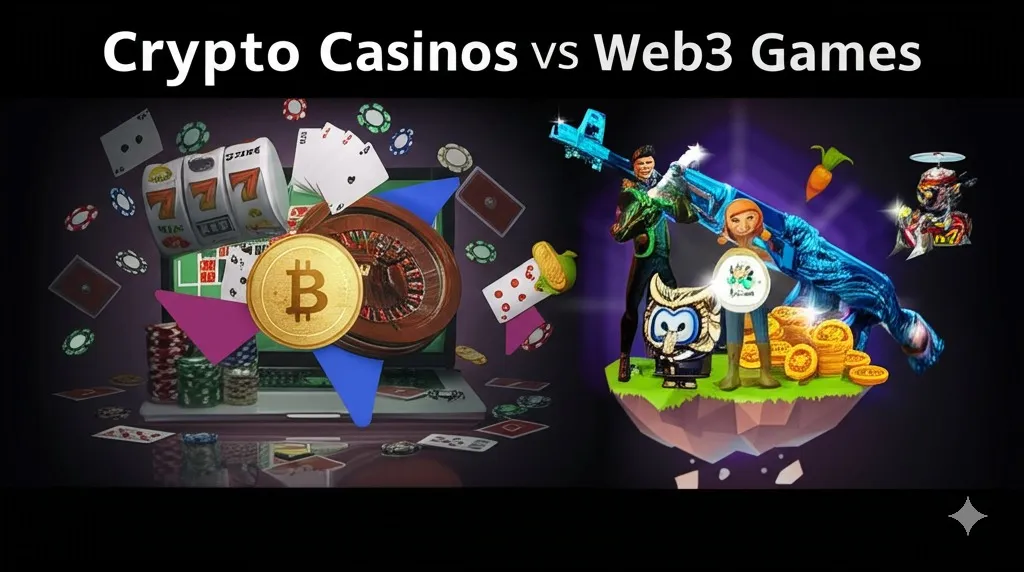Blockchain technology continues to reshape industries, and the gaming sector is at the forefront of its impact. Crypto casinos and Web3 games have emerged as two of the most engaging platforms for users, offering unique experiences through decentralized systems. By 2025, both are not only competing for attention but also for user spending. The data shows significant momentum for Crypto Casinos, thanks to their seamless transactions and immersive functionality, while Web3 games captivate audiences with ownership-driven gameplay and NFTs. This blog explores where users are putting their money and why these two sectors are transforming how we interact with entertainment and blockchain.
The Appeal of Crypto Casinos

By prioritizing speed, transparency, and safety, crypto casinos have become a favorite choice for users in 2025. These platforms combine blockchain technology with traditional gambling experiences, advancing the industry in ways traditional casinos cannot. Below, we break down three major reasons for their ever-growing appeal: faster payments, improved security, and user demographics that drive their success.
Faster Transactions and Cost-Effectiveness
One of the main reasons users gravitate toward crypto casinos is their ability to offer instant withdrawals and deposits. Payments through cryptocurrencies eliminate the middlemen, like banks or payment processors, drastically reducing wait time. Traditional casinos or online gambling platforms often delay payouts by 3 to 5 business days, but crypto casinos complete transactions in minutes—or even seconds—for cryptocurrencies such as Bitcoin or Ethereum.
Apart from speed, the cost savings are significant. Processors like Visa, PayPal, and traditional wire transfers charge hefty fees, which eat into players’ winnings. In contrast, blockchain-based systems have low-to-zero transaction costs, allowing users to keep more of what they win. Some crypto casinos have also begun accepting altcoins like Solana and Polygon, which feature even lower fees, making gaming accessible to a broader audience with varying financial preferences.
For casual players or high rollers, efficient payments are crucial. Slow payouts can discourage players, but with crypto casinos, money moves as fast as the thrill of winning.
Enhanced Security and Transparency
Crypto casinos stand out thanks to their blockchain-backed infrastructure, where trust isn’t just promised—it’s guaranteed. Every wager, payout, and game result is immutably recorded on the public ledger. This feature ensures fair play, as users can independently verify the outcomes of games through “provably fair” algorithms. This innovation, common in platforms like BC.Game and Stake, has redefined fairness in an industry often plagued by skepticism.
Additionally, smart contracts automate transactions and enforce rules without human intervention, reducing the risk of manipulation, fraud, or payment disputes. For players concerned about data breaches, using cryptocurrencies removes the need to share sensitive personal or financial data, enhancing anonymity. Platforms also implement advanced encryption and two-factor authentication, ensuring accounts remain secure against cyber threats.
As gambling attracts a global user base, concerns about transparency and safety are heightened. Crypto casinos provide the solution, using decentralized systems to eliminate the shadowy unpredictability of traditional gambling outfits.
Demographic Insights
The user profile for crypto casinos reveals key trends in 2025. Predominantly, the 25-40 age group dominates the player base, comprising a mix of millennials and Gen Z users who are already accustomed to cryptocurrencies and blockchain technologies. This tech-savvy segment values control, fairness, and convenience—traits synonymous with crypto casinos.
Male users still represent the bulk of the audience, though the number of female players has shown year-over-year growth due to targeted marketing campaigns and community-focused features. Regionally, platforms gain considerable traction in Southeast Asia, Latin America, and parts of Eastern Europe, where cryptocurrency adoption is accelerating and local regulations around online gambling are lenient. High smartphone usage in these regions also supports mobile-friendly crypto casino apps, further encouraging participation.
Interestingly, crypto casinos also attract cryptocurrency investors who see gambling as both entertainment and an opportunity to grow their digital assets. These platforms meet the needs of diverse users, from skilled gamers to casual spenders, reinforcing their global appeal.
Web3 Games: The Shift from Play-to-Earn Models

As Web3 technology matures, the gaming industry is moving beyond the initial hype of play-to-earn (P2E) models, redefining itself with player-focused ecosystems and sustainable in-game economies. By 2025, the conversation around Web3 games isn’t propelled by speculative profits but by immersive experiences, decentralization, and genuine asset ownership. Here’s a look at three game-changing aspects reshaping Web3 gaming today.
Integration of NFTs
Non-fungible tokens (NFTs) have transitioned from collectibles to essential tools in shaping new gaming experiences. Unlike prior models where NFTs dominated gameplay and overwhelmed users, the industry now sees NFTs as optional features that enhance rather than dictate the experience.
These optional NFTs represent customizable assets like weapons, skins, or exclusive in-game items that provide value without disrupting core gameplay. A key difference is the freedom they give players. You’re not forced into financial ecosystems; instead, those interested in deeper engagement or monetization can buy, trade, or sell these items on decentralized marketplaces.
For developers, NFTs unlock creative avenues for monetization without relying on hefty upfront purchases or aggressive microtransactions. Players get actual ownership of assets they use, transcending the traditional limitations of centralized systems where items are lost when a game shuts down. Now, imagine owning a virtual sword that works across multiple games or blockchain platforms—this is the kind of functionality making NFTs valuable in 2025’s Web3 gaming space.
Popularity of Decentralized Game Platforms
Decentralized platforms are revolutionizing how games are hosted and played. By 2025, some of the breakout successes in Web3 gaming are Telegram-based games, which combine seamless user accessibility with blockchain functionality. These games leverage Telegram’s massive global user base and simple onboarding process, effectively bypassing the friction often associated with decentralized apps.
Projects like “GameFi Pulse” and others have reached millions of active users globally, showcasing that blockchain gaming doesn’t have to be overly complex to be successful. Players log in with minimal steps, use crypto wallets native to such platforms, and engage in games built around simplicity yet rich with features that encourage longer playtime.
The growing popularity of these platforms shows that users value accessibility and innovation. Additionally, decentralized game platforms are earning trust by implementing transparent mechanics such as provable ownership and fair play algorithms. Blockchain isn’t a gimmick here; it’s an enabler of fluid transactions, efficient economies, and player empowerment.
Player-Centric Design and Community Focus
One of the most exciting shifts in Web3 gaming is the prioritization of player immersion and community building. Developers are no longer designing games solely for short-term profit driven by speculative P2E structures. An emerging trend is creating decentralized autonomous organizations (DAOs) for players to actively contribute to game development and governance, fostering deeper engagement.
In 2025, our focus is on what players want, not what investors demand. Games are emphasizing narratives, real-time interactivity, and features that strengthen community ties, like co-op missions and collaborative events. For example, projects such as “Players’ Galaxy” encourage voting on critical updates, fostering a sense of ownership that isn’t limited to digital assets.
Web3 communities are also more than passive spectators. They actively shape marketing campaigns, influence ecosystem growth, and ensure continuous player feedback reaches developers. This collaborative approach ensures longevity and relevance—it’s not about who earns the most but who enjoys the game the longest.
Key Differences in User Spending Patterns
In 2025, crypto casinos and Web3 games find themselves capturing distinct audiences with unique spending behaviors. While both operate on blockchain technology, their overarching purpose and the motivations behind user spending differ significantly. Understanding these patterns sheds light on how each sector plays to its strengths, shapes user engagement, and impacts the broader digital economy.
Spending Motivation
Spending behavior in crypto casinos and Web3 games is heavily influenced by the core motivations of their users. Each platform appeals to its audience for reasons that go beyond simple entertainment, and these motivations drive how users allocate their money.
- Crypto Casinos:
For players in crypto casinos, the primary drivers of spending include the thrill of risk, profit-seeking, and immediate gratification. Users here are drawn to games like slots, poker, or roulette, where chance and skill intertwine. The biggest spending motivation? Potential profit. Players gamble with cryptocurrency—not just for fun, but for the potential to multiply their assets. Loyal programs, VIP perks, and cashback incentives further encourage high rollers to spend more. Emotional factors also come into play. The psychological high of a big win, combined with seamless functionality like fast withdrawals, makes it easy for users to continue playing. Unlike traditional gambling, crypto casinos often allow users to stay anonymous, which appeals to those seeking privacy, especially in regions with stringent gambling laws. - Web3 Games:
Spending in Web3 games is largely driven by ownership, community, and engagement. Players invest in in-game assets such as NFTs (non-fungible tokens), which represent skins, weapons, avatars, and other collectible items. These digital goods aren’t ephemeral—they have real-world value and can be bought, sold, or even used across multiple platforms. For Web3 gamers, spending isn’t just about instant gratification; it’s about acquiring assets they own and control. Moreover, social interactions play a huge role. Games relying on guilds, clans, or player-driven economies create an environment where collaboration is fueled by peer encouragement to spend on upgrades or enhancements. The push toward decentralized governance through DAOs also fosters investment in the gaming ecosystem itself, with many users directly supporting or shaping the project’s future.
Economic Impact of Each Ecosystem
Both crypto casinos and Web3 games leave a unique imprint on their respective industries, contributing significantly to the blockchain economy in 2025. Their financial impact is measured not just in monetary terms but also in how they influence adoption and innovation.
- Crypto Casinos:
The economic footprint of crypto casinos is substantial. In 2025, these platforms are driving billions in daily turnover. They democratize gambling by bypassing traditional banking systems, making casino gaming accessible to a global audience—even in regions where credit card payments or fiat money gambling are restricted. The fast-paced nature of transactions and a growing variety of accepted cryptocurrencies (e.g., Bitcoin, Ethereum, and stablecoins like USDT) contribute to increased spending. Crypto casinos have also fueled blockchain adoption among non-tech-savvy users. Gambling platforms like Stake and BC.Game have shown that you don’t need an advanced understanding of Web3 to participate, drawing in a broader market and circulating more capital into the crypto economy. In turn, some governments are taking notice, with licensing and regulations tailored around blockchain casinos to ensure compliance and taxation. - Web3 Games:
Web3 games contribute a different type of value to the digital economy. With users participating in decentralized ecosystems, these games emphasize financial empowerment through ownership. Players don’t just spend money; they create value. For example, tokenized game economies allow players to participate in staking or lending, turning them into active participants rather than passive consumers. Investment in Web3 gaming development hit record highs in 2025, with venture capital heavily focused on GameFi platforms. Reports estimate that the sector attracted over $1 billion in funding just during the first quarter, underscoring its economic significance. Unlike crypto casinos, Web3 games also support a thriving secondary market for in-game items, which has become a standalone industry. Furthermore, these platforms generate financial opportunities beyond gameplay. Streamers, content creators, and esports organizations built around blockchain games are receiving sponsorships and ad revenue, fostering an entire ecosystem where spending directly leads to earning. Developers, too, thrive on innovative monetization models, sidestepping aggressive microtransactions seen in traditional gaming to rely on NFT sales and revenue-sharing systems.
Both ecosystems are carving unique niches in the blockchain economy, appealing to distinct mindsets. By understanding what drives spending in each sector, it’s evident why users are embracing these platforms in unparalleled ways in 2025.
The Future of Crypto Casinos and Web3 Games
As blockchain adoption accelerates, the boundaries between entertainment platforms like crypto casinos and Web3 games are becoming more defined, yet increasingly complementary. Both sectors are rapidly evolving due to advancements in technology and shifting user expectations. By 2025, these innovations will pave the way toward immersive, decentralized experiences while also grappling with regulatory and market challenges. Looking ahead to 2030, the convergence of blockchain-based gaming and crypto gambling signals a future where users may have seamless access to both financial and entertainment ecosystems in one centralized platform.
Projected Growth and Emerging Features
The trajectory for crypto casinos and Web3 games points to exponential growth, fueled by innovation in AI integration, tokenized rewards, and increasingly blended entertainment models.
- Artificial Intelligence (AI) in Operations and Gameplay: AI will play an integral role in both crypto casinos and Web3 games, enhancing user experience and operational efficiency. In crypto casinos, AI-driven systems will improve fraud detection, generate tailored recommendations for players, and optimize rewards structures. Meanwhile, AI in Web3 games could deliver dynamic storytelling or adaptive gameplay, giving users more personalized interactions akin to the most advanced AAA games seen today.
- Tokenized Rewards for Deeper Engagement: Rewards systems are transitioning into tokenized ecosystems. Both platforms are enabling ownership-driven incentives that directly engage users. Crypto casinos are adopting staking mechanisms where players can earn rewards by locking tokens, essentially turning games into investment opportunities. Similarly, Web3 games are continuing to use NFTs and cryptocurrencies not just for cosmetic upgrades but as tools for investment, utility, and cross-platform interoperability.
- Hybrid Gaming Experiences: As user expectations evolve, hybrid gaming models are emerging. Developers are beginning to experiment with platforms that blur the lines between gambling and traditional gaming. For example, players in Web3 games might engage in skill-based missions that ultimately lead to higher chances or bonus perks in associated crypto casino ecosystems. This fusion of gaming and gambling could redefine how users perceive and interact with digital platforms.
In 2025, crypto casinos are expected to attract significant revenue per user, with some projections forecasting average spending as high as $4,300 annually per player. Web3 games, meanwhile, are expected to outpace many traditional gaming sectors, leveraging decentralization to achieve a broader audience and a market valuation potentially exceeding $104.5 billion by 2030.
Challenges and Opportunities
While growth metrics and emerging technologies are encouraging, both sectors face considerable challenges. These obstacles, however, also reveal opportunities for innovation and differentiation.
- Regulatory Complexities: The legal framework surrounding blockchain gaming and gambling remains fragmented. Crypto casinos are particularly vulnerable, as countries struggle to regulate online gambling involving digital tokens. In some regions, aggressive regulation could stifle growth, while in others, new licensing frameworks might drive legitimacy and adoption. Web3 games face similar scrutiny, particularly due to the financial instruments used in games that resemble securities in many jurisdictions.
- Opportunity: Platforms adhering to best practices in compliance, such as acquiring blockchain-focused gambling licenses or partnering with legally compliant entities, could capture untapped markets left behind by less regulated actors.
- Market Volatility: Cryptocurrency price swings remain a hurdle for both sectors. In crypto casinos, volatile token values can discourage user spending or lead to unpredictable rewards. Web3 games encounter challenges when in-game economies are pegged to fluctuating asset values, which could erode trust in the platform.
- Opportunity: Stablecoins have already started bridging this gap. By integrating tokens like USDT or USDC, platforms can sidestep volatility while retaining the benefits of blockchain-based transactions. Moreover, new tokenomics frameworks could stabilize in-game economies, ensuring fair value for both players and developers.
- Competition and Adoption: Traditional casinos are integrating cryptocurrency payments, and legacy gaming studios are experimenting with blockchain technology, making competition fiercer. Both sectors need to continue to innovate to avoid losing market share to these legacy institutions entering the space.
- Opportunity: Exclusive partnerships, enhanced user interfaces, and community-driven governance models are prime areas for differentiation, offering unique value propositions compared to non-blockchain competitors.
- Player Expectations: Both crypto casinos and Web3 games face the challenge of delivering not just functionality but immersive, enjoyable experiences. Users in 2025 will not settle for platforms that compromise on design, speed, or accessibility.
- Opportunity: By prioritizing streamlined onboarding, high-quality gameplay, and accessible features, these platforms can broaden their global audience, especially in regions that exhibit high smartphone penetration and increasing crypto adoption (e.g., Southeast Asia and Latin America).
Looking further, the eventual merging of these blockchain sectors may mitigate their individual challenges. By creating interconnected ecosystems, users might enjoy the thrill of casino gaming alongside the asset ownership and community engagement of Web3 platforms, moving seamlessly across both categories.
Conclusion
Crypto casinos and Web3 games are redefining user spending habits in 2025, each carving out distinct spaces within the blockchain economy. Crypto casinos attract users seeking speed, anonymity, and financial incentives, while Web3 games foster engagement through digital ownership and community-driven ecosystems.
Both sectors reflect the broader trend of blockchain adoption through personalized, transparent, and decentralized platforms. Users are expected to continue prioritizing crypto casinos for their seamless transactions and instant rewards, whereas Web3 games will thrive by creating immersive experiences that combine entertainment with tangible value.
As they evolve, these ecosystems are likely to complement one another, hinting at a future where gaming and gambling intersect seamlessly on blockchain-powered platforms. The journey will be defined by innovation, regulation, and growing consumer demand, making this an exciting era for digital entertainment.



1 Comment
zoritoler imol
I really enjoy reading through on this website , it holds excellent posts.